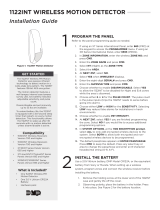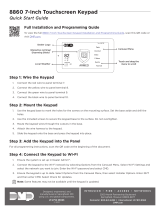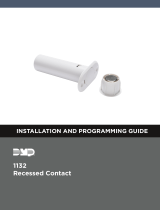Page is loading ...

1126R WIRELESS CEILING-MOUNT
360° PIR MOTION DETECTOR
Installation Guide
DESCRIPTION
Figure 1: 1126 Housing
1
The 1126R Wireless Ceiling-Mount
PIR Motion Detector is a 360° PIR
(passive infrared) device designed
for a variety of ceiling-mount
applications.
Its compact design provides a
small sensor that can be remotely
configured. The 1126R has excellent
RFI and noise immunity. The pulse
count feature allows for multiple
trips before an alarm is initiated.
The 1126R features
Disarm/Disable functionality. When
this option is enabled, Zone Tripped
messages disable when the system
is disarmed to allow for extended
transmitter battery life. Supervision,
Tamper, and Low Battery are the
only messages that are sent to the
panel when the system is disarmed.
Compatibility
All DMP 1100 Series Wireless
Receivers and panels.
PROGRAM THE PANEL
OPEN THE 1126R
2
What is Included?
• One 1126R Wireless Ceiling-Mount
360° PIR Motion Detector
• Two CR123A 3.0V lithium
batteries
When programming the 1126R in the panel, refer to the panel
programming guide as needed.
1. Enter 6653 (PROG) to access the PROGRAMMER menu.
2. Navigate to ZONE INFORMATION and enter the wireless
ZONE NO:- and press CMD.
3. Enter the ZONE NAME and press CMD.
4. Select NT (night) as the ZONE TYPE and press CMD.
5. Select the AREA:.
6. At the NEXT ZN? prompt, select NO and press CMD.
7. Select YES when WIRELESS? displays and press CMD.
8. Enter the eight-digit SERIAL# and press CMD.
9. Enter the SUPVSN TIME and press CMD.
10. At DISARM DISABLE, select NO or YES and press CMD.
11. Enter the PULSE COUNT and press CMD.
12. Select LOW or HIGH for the SENSITIVITY level and press
CMD.
13. At the NEXT ZN? prompt, select YES if you are finished
programming. Select NO for additional programming
options.
1. Remove the locking screw from the side of the 1126R.
2. Remove the plastic dome by gently squeezing the sides of
the dome and lifting it o the cover.
3. Hold the base and twist the cover counterclockwise until
the 1126R separates. See Figure 2.
Figure 2: Open the 1126R
Plastic Dome
Base
Cover

2 DIGITAL MONITORING PRODUCTS | 1126R INSTALLATION GUIDE
SELECT A LOCATION
4The 1126R provides a Survey LED capability to allow one
person to confirm communication with the wireless receiver
or panel while the cover is removed. This allows you to
determine the best location for the 1126R. Review the
Location Dos and Don’ts and refer to Table 1 for information
on how much area will be covered based on the height of the
installation location. Then, check the location using the Survey
LED Operation.
Location Dos
• Do locate on a rigid vibration-free surface.
• Do locate so the expected intruder’s movement will be across the covered radius. See Table 1.
• Mount the device between 6.5-18ft high.
Location Don’ts
• Don’t locate on any area containing excessive metallic surfaces.
• Don’t locate with direct sunlight, heat sources (heaters, radiators, etc.), or strong air drafts (fans, air
conditioner, etc.) in the field of view.
• Don’t locate facing areas that may rapidly change temperature.
HEIGHT OF CEILING (FT.) COVERED RADIUS (FT.) NUMBER OF PIRS TO USE
6.5-11ft 20ft 1
12ft 30ft 1
13-18ft 45ft 2 (Spaced 10ft apart)
Check the Location Using a Survey LED
1. Hold the 1126R in the exact desired location.
2. Locate the LED on the 1126R PCB. (It is labeled LED).
3. Use a screwdriver or a long tool to press the tamper switch to send data to the panel. Determine if
communication is confirmed or faulty.
Confirmed: If communication is confirmed, the LED turns on when data is sent to the receiver
and o when acknowledgement is received. Proper communication between the 1126R
and panel is verified when for each press or release of the tamper switch, the LED blinks
immediately on and immediately o.
Faulty: If communication is faulty, the LED remains on for about 8 seconds or flashes multiple
times in quick succession. Relocate the 1126R or wireless receiver until the LED confirms clear
communication.
INSTALL THE BATTERIES
3Use 3.0V lithium batteries, DMP Model CR123A batteries,
or the equivalent from Sony or Murata. Keep in mind, when
setting up a wireless system, program zones and connect the
wireless receiver before installing the batteries. With the 1126R
open, observe polarity and place the batteries into the battery
holders. See Figure 3.
Figure 3: Battery Location
Table 1: Measurement Information
Tamper
Switch

1126R INSTALLATION GUIDE | DIGITAL MONITORING PRODUCTS 3
TEST THE 1126R
6
MOUNT THE 1126R
5
Perform a Wireless Walk Test and a PIR Walk Test to confirm
the 1126R is communicating with the panel and it’s operating correctly.
Wireless Walk Test
1. Enter 8144 (WALK) at the keypad and press CMD.
2. Press CMD and select WLS.
3. If the 1126R fails to check in at the keypad, relocate the 1126R or wireless receiver.
PIR Walk Test
The Wireless PIR Walk Test is a 30-minute test that allows you to verify proper operation of the 1126R.
1. Enter 8144 (WALK) at the keypad and press CMD.
2. Press CMD and select PIR.
3. Enable the device LED by waiving your hand in front of the 1126R. The LED flashes on and o for each
trip, confirming proper operation. If the 1126R LED fails to flash on and o for each trip, relocate the
1126R or wireless receiver.
Replace the Batteries
1. Open the 1126R and remove the old batteries. See Open the 1126R.
2. Observe polarity and place the new batteries in the holder and press into place.
3. Close the 1126R.
Sensor Reset to Clear LOBAT
After the batteries are replaced, a LOBAT message displays on the keypad. A sensor reset is required
at the keypad to clear the LOBAT message.
1. On a Thinline Keypad, press and hold 2 for two seconds. On a Graphic Touchscreen Keypad,
press RESET.
2. Enter a user code if required. The keypad displays SENSORS OFF followed by SENSORS ON.
Additional Information
Figure 4: Mounting Hole Locations
Mounting Holes
1. Hold the base of the 1126R in the desired location.
2. Use the supplied screws to mount the base in place. See
Figure 4 for mounting hole locations.
3. Place the cover back on the base and twist clockwise.
4. Insert the locking screw into the base and secure the
1126R housing together.

Designed, engineered,
and manufactured in
Springfield, Missouri using U.S.
and global components.
LT-0971 18102
INTRUSION • FIRE • ACCESS • NETWORKS
2500 North Partnership Boulevard
Springfield, Missouri 65803-8877
866.266.2826 | DMP.com
Patents
U.S. Patent No. 7,239,236
Compatibility
• XT30/XT50 Series Panels running Version 102 or higher
• XR150/XR550 Series panels
• 1100D Wireless Receivers
• 1100DI/DH Wireless Receivers running Version 105 or higher
• 1100X Wireless Receivers running Version 104 or higher
• 1100XH Wireless Receivers running Version 105 or higher
Certifications
FCC Part 15: CCKPC0152
Industry Canada: 5251A-PC0152
1126R Wireless Ceiling-Mount
360° PIR Motion
Detector
Specifications
Battery
Life Expectancy 5 to 7 years
Type 3.0V lithium CR123A
Transmit condition Alarm, Low Battery
Mounting height 6.5-18 ft.
Frequency Range 905-924MHz
Dimensions
4.0”D x 2”H
Color White
FCC INFORMATION
This device complies with Part 15 of the FCC Rules. Operation is subject to the following two conditions:
1. This device may not cause harmful interference, and
2. this device must accept any interference received, including interference that may cause undesired operation.
Changes or modifications made by the user and not expressly approved by the party responsible for compliance could
void the user’s authority to operate the equipment.
This equipment has been tested and found to comply with the limits for a Class B digital device, pursuant to part 15 of
the FCC Rules. These limits are designed to provide reasonable protection against harmful interference in a residential
installation. This equipment generates, uses and can radiate radio frequency energy and, if not installed and used
in accordance with the instructions, may cause harmful interference to radio communications. However, there is no
guarantee that interference will not occur in a particular installation. If this equipment does cause harmful interference to
radio or television reception, which can be determined by turning the equipment o and on, the user is encouraged to
try to correct the interference by one or more of the following measures:
• Reorient or relocate the receiving antenna.
• Increase the separation between the equipment and receiver.
• Connect the equipment into an outlet on a circuit dierent from that to which the receiver is connected.
• Consult the dealer or an experienced radio/TV technician for help.
The 1100 Series wireless system is a two-way supervised wireless design. It is compliant with FCC rules as they pertain
to 900 MHz Spread Spectrum devices. In rare instances it has been observed that certain 900 MHz cordless telephones
may occasionally experience a clicking sound on the telephone while in use. If this occurs, it may be resolved by
selecting a dierent channel on the cordless telephone, or replacing the cordless phone with a dierent brand or model
of 900 MHz telephone or other cordless telephone. To comply with RF exposure requirements, a minimum distance of
20cm must be maintained between the antenna and all persons.
INDUSTRY CANADA INFORMATION
This device complies with Industry Canada Licence-exempt RSS standard(s). Operation is subject to the following two
conditions:
1. This device may not cause interference, and
2. this device must accept any interference, including interference that may cause undesired operation of the device.
This system has been evaluated for RF Exposure per RSS-102 and is in compliance with the limits specified by Health
Canada Safety Code 6. The system must be installed at a minimum separation distance from the antenna to a general
bystander of 7.87 inches (20 cm) to maintain compliance with the General Population limits.
Le présent appareil est conforme aux CNR d’Industrie Canada applicables aux appareils radio exempts de licence.
L’exploitation est autorisée aux deux conditions suivantes:
1. l’appareil ne doit pas produire de brouillage, et
2. l’utilisateur de l’appareil doit accepter tout brouillage radioélectrique subi, même si le brouillage est susceptible
d’en compromettre le fonctionnement.
L’exposition aux radiofréquences de ce système a été évaluée selon la norme RSS-102 et est jugée conforme aux limites
établies par le Code de sécurité 6 de Santé Canada. Le système doit être installé à une distance minimale de 7.87 pouces
(20 cm) séparant l’antenne d’une personne présente en conformité avec les limites permises d’exposition du grand
public.
/














